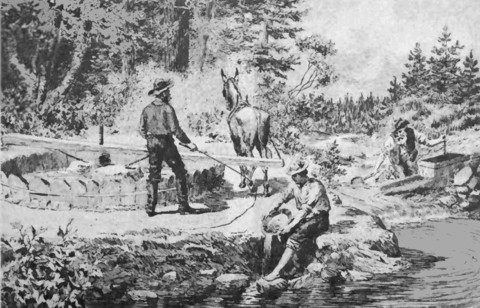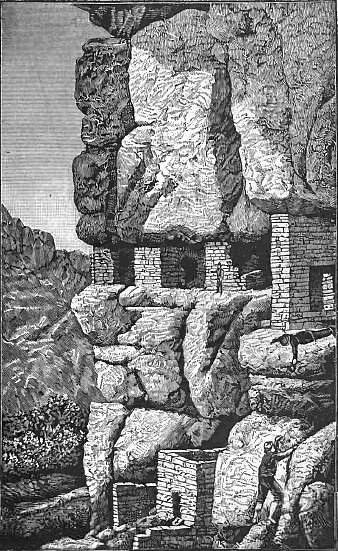Prescott, once the capital of the state Arizona, and the county seat of Yavapai county, is situated in a beautiful mountain glade, surrounded by the northern spurs of the Sierra Prieta. The town was laid out in May, 1864, and named in honor of the eminent American writer and standard authority upon Aztec and Spanish American history. Its site is in latitude 34° 30' north, and in longitude 112° 30' west from Greenwich. The town has a beautiful situation, being surrounded by low hills, crowned with lofty pines, and covered with fine grasses. The streets are broad and laid out with the cardinal points of compass. In the center of the town is a large plaza, in which stands the county court-house, the finest structure in the Territory. It is built of brick and stone, two stories in height, with a mansard roof, crowned by a handsome tower. Prescott has the appearance of a homelike, Eastern town. Its buildings are of wood, brick, and stone. It contains the handsomest mercantile establishments in the Territory, many of which would be a credit to older and more pretentious communities.
It is the center of an extensive mining, pastoral, and agricultural region, and has a large and prosperous trade. Besides its fine business establishments, Prescott can show many elegant private residences. It has a fine theater and a large public hall. Three saw mills are in constant operation near the town. Prescott has one bank, a fine brick structure 72 by 29 feet, and two stories in height, two hotels, three breweries, fifteen mercantile establishments, and, like all frontier towns, numerous saloons. The town is situated about 5,500 feet above sea level, and possesses one of the most delightful climates on the North American continent; and with its pine-covered hills, green valleys, and beautiful gardens, is one of the most attractive towns on the Pacific coast. The Catholics, the Methodists, the Baptists, the Presbyterians and the Congregationalists all have handsome churches. A fine brick school-house, two stories in height, is one of the ornaments of the town. The Masons, the Odd Fellows, the Knights of Pythias, and the Foresters have flourishing societies.
Two newspapers are published here, the Arizona Miner, the oldest newspaper in the Territory, and the Arizona Democrat. The former is conducted by C. W. Beach, and is untiring in its efforts to give publicity to the vast resources of Northern Arizona. The Democrat is owned and edited by Hon. Gideon J. Tucker, formerly of the Albany Argus and the New York Daily News. It is ably conducted, and justly appreciated for its devotion to the material interests of the Territory. The population of Prescott is about two thousand. With its charming situation, fine climate, and the varied resources which surround it, the town is destined to be a place of importance.
The historic record of the area tells us that the Walker party struck Groom Creek May 7, 1863, and there from spread into all the likely-looking gulches roundabout. In June they found diggings on Lynx Creek, where Sam C. Miller killed a lynx and George Colter got $350 from the washing of a single pan. In October of the same year, the Lount party of thirteen from California made camp in Miller Valley. It is claimed that this party made the first location under American laws of any lode mine north of the Gila. It was on Lynx Creek, called the "Pride of Arizona," and the notice was recorded December 27, 1863. Charlie Genung claims that the first lode mine located in the Yavapai hills was the Montgomery, staked out by a party of which he was a member late in 1863. The fame of the gold diggings had spread, for the Walker party and others of the first comers were more than anxious for a larger settlement, in order to secure better protection against the Apaches. In November, twenty four miners, including Ed Peck, arrived from New Mexico and joined the Miller Valley colony.
While some of the creek beds of Yavapai County are washed for native gold to this day, the era of placer gold mining soon was succeeded by that of silver lode mining, that in turn by gold mining and it again, by the development of the copper industry. By 1875 on the Hassayampa, twenty-five miles south of Prescott, had been installed a 30-ton smelting furnace, to work the silver-lead ores of the Crescent and other mines of the locality. Over in the Bradshaws had been found the Tiger, Del Pasco, War Eagle, Peck, Black Warrior, Tuscumlia and Silver Prince. Possibly best known of all of these was the Peck, which had a five-foot body of horn silver chloride within which a pay streak seemed about one half silver. The ores were reduced at a pioneer quartz stamp mill at Aztlan, six miles south of Prescott. The Peck was discovered in 1875 by Ed C. Peek, C. C. Bean, William Cole and T. M. Alexander. Peck found the first heavy silver float as he was stooping to drink from a spring. In 1877 the property was capitalized in San Francisco. Then there was litigation and, though over $1,000,000 is said to have been taken from the mine in its first few years, little has been realized from it since.
One of the early properties was the Senator, on the upper Hassayampa, which had a ten stamp mill early in the seventies. Rice and the Elliott brothers discovered the Accidental in 1864 near Lynx Creek. The well-known Poland, named after one of its discoverers, is of pioneer rating, as is the Silver Belt, near Big Bug, from which lead-silver ores were worked in a furnace on the Agua Fria. Still further to the northward Charles Spencer, Dan O'Leary and other daring prospectors made their way into the canyons of the Colorado and down into the mysterious gorge of Cataract Creek, where they found horizontal veins of silver ore of great richness, but in spots almost inaccessible on the sides of the cliffs.
Jack Swilling, Bob Groom, Ed Peck, Jack Moore and a number of other noted pioneer Arizonans, were busy in the hills of Yavapai County in this period, defying the Indians, but leaving behind little more than a history of their deeds. The Tip Top probably was the leading mine of the Bradshaws during the late seventies and its stock was listed on the San Francisco board.
Return
to The Arizona Page:
Arizona Gold Rush Mining History



